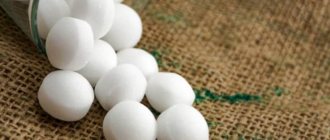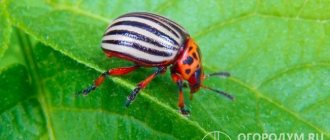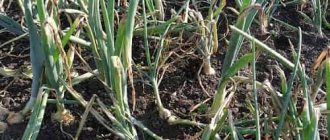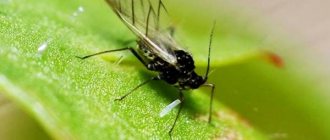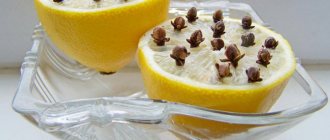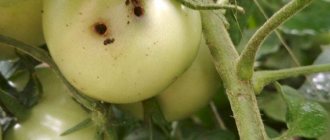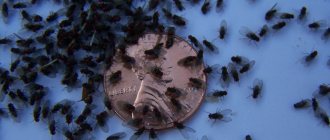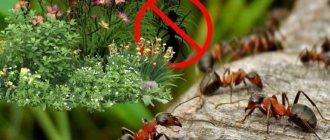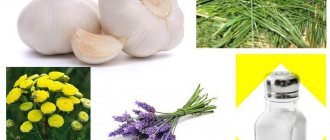The fight against onion fly begins with preventive work. I told you in the article how to protect your garden from the invasion of an insidious pest.
But if last season the fly was active in onion plantings, prevention alone will not be enough.
Today we will talk exclusively about folk remedies . After all, chemicals belonging to the class of heavy artillery are equally dangerous for humans and local fauna.
Terms and rules of processing
Since the fly flies specifically at the onion scent, most folk methods are designed to mask the characteristic smell of the plant. The other part creates uncomfortable conditions for the insect to reproduce. And only a small proportion is aimed at direct destruction of larvae.
The fly breeds throughout the summer, so spraying is done regularly at intervals of 5-14 days (depending on the substance, weather and the development cycle of the fly offspring). During intensive flight phases, irrigation is carried out more often (every 3-5 days), at other times - less often.
The first flight occurs at the moment of flowering of dandelions, lilacs, and fruit trees.
The second flight is in 35-45 days.
The third flight is in another 35-45 days.
Description of the pest
Despite its name, the onion fly, in addition to various types of onions (onions, leeks, chives), also damages garlic, some types of lettuce and bulbous flowers (primarily tulips). The pest affects crops not only in open ground, but also in greenhouses.
Appearance and life cycle
The onion fly is an inconspicuous, small (about 7 mm) insect of ash-gray or yellow-gray color. The pest belongs to the order Diptera and is very similar to the common housefly. The wings are transparent and may have two or three longitudinal veins or without them. At the edges of the wings there is a fringe of thin long hairs.
The onion fly is a small insect (7 mm), very similar in appearance to an ordinary housefly
The female lays from 40 to 60 eggs during her life, and from 5 to 20 at a time. Their size is about 1 mm. The eggs are white and have an elongated oval shape. Embryonic development is promoted by high soil moisture (60–80%). After about a week, larvae up to 10 mm in size emerge from them, which immediately penetrate into the bulb. They are legless and white. The body tapers towards the head, which has black mouth hooks. Larvae born from the same clutch stick together and eat away a single cavity inside the bulb.
The fly lays from 5 to 20 eggs at a time, from which, after a week, larvae hatch, which eat the bulbs and feathers
After 15–20 days, the larvae leave the bulbs, crawl into the ground and pupate there, forming a false cocoon. After 2–3 weeks, young flies of the next generation emerge from the pupae. This usually happens in July. In total, two generations of onion fly develop during the season; in the southern regions, under favorable conditions, a third generation may appear. The pest overwinters in the soil of those areas where the larvae developed, at a depth of 5–20 cm in the form of false cocoons.
The onion fly overwinters in the soil at a depth of 5–20 cm in the form of a pupa (false cocoon)
What harm does the onion fly cause?
The period of appearance of the onion fly depends on climatic conditions and varies in different regions from late April to early June. The main landmark for the beginning of the mass emergence of the pest is the moment of flowering of dandelions, lilacs and cherries.
As soon as the cherry blossoms, the gardener must be on alert - the massive flight of the onion fly begins
Adult flies do not eat onions; they feed on pollen from flowering plants. Their harm lies in the fact that females actively lay eggs during the season in the soil, on protruding parts of the bulbs or between the leaves. Fly larvae cause direct harm. They attack onions of the first and second years of development. In seedlings, the larvae damage the feathers. In onions of the second year of growing season, they crawl through the axils of the leaves into the bulb or penetrate it from the bottom, suck out the juice and eat away the pulp, as a result of which the bulbs rot and the plants die.
Causes of defeat
The fight against onion flies that have already appeared can be quite difficult and not always successful. To carry out timely and correct preventive measures, it is necessary to know the reasons for the mass invasion of the pest on onion beds. Among them are:
- violation of crop rotation rules;
- incorrect placement of crops in the garden (poor choice of neighbors);
- late planting of onions;
- lack of deep autumn digging of the soil;
- use of infected and untreated seed material before planting.
No. 1. Wood ash
This is the most affordable way to combat onion flies. After watering or rain, ashes are applied to the row spacing at a rate of 100 g/m. and sealed with a flat cutter or hoe. The procedure is repeated every 10-14 days.
On a note. To enhance the effect, for every 100 grams of ash, you can add 25-30 grams of tobacco powder, as well as a teaspoon of hot ground pepper.
Ash infusion will also help protect the plantings. To do this, add 400-500 grams of ash to 10 liters of warm water and leave for 24 hours. After filtration, 30-50 grams of laundry soap are added to the mixture. Consumption is 1-1.5 liters per linear meter of bed.
Video about a quick way to get rid of onion flies
The method demonstrated in the video will help get rid of onion flies in the beds within 20 minutes after treatment. To prepare the product, tobacco dust, harmless to humans, is used. The author reveals a secret that will help increase the effectiveness of this method several times. We recommend you watch it!
The onion fly is a dangerous parasite that completely destroys onion seedlings. It must be dealt with in a timely manner, since it can survive in the soil for several years. It is necessary to select high-quality drugs for treatment, as well as use methods of prevention. Then the problem can be resolved in a short time.
No. 2. Potassium permanganate
Some gardeners believe that potassium permanganate is fatal not only to pathogens, but also to the brood of various pests.
To prevent the onion fly from multiplying, they water the onion plantings with a solution of manganese (a teaspoon per 8-10 liters) three times. The first time at the time of disembarkation, then at intervals of 7-10 days.
But I note that the solution will only work in high concentration . This will cause the death of many beneficial soil inhabitants and also damage plant roots. Therefore, I personally do not use this product.
Preventing the appearance of insects
Due to the danger of harmful insects appearing in any place where onions grow, preventive measures are needed:
- change of landing site;
- planting near marigolds, nightshades or carrots;
- autumn digging of the site;
- early application of insecticides to the ground during planting;
- regular loosening of the beds;
- use of high-quality seed material.
You can repel the pest with strong-smelling safe compounds and by planting herbs.
There are many chemicals and folk remedies to get rid of the pest. To quickly cope with the problem, you need to act comprehensively. Because folk remedies cannot solve the problem on their own. Only through the step-by-step implementation of all the described actions can you grow a healthy crop.
No. 3. Metronidazole
The well-known antibacterial drug is widely used by gardeners. Including pest control.
The recipe for the solution is simple: 5-10 tablets per 10 liters of water. The onion is processed when the feather height is 5-10 centimeters. It is believed that the larvae die after a single treatment.
Reviews about the method are mixed - the chance that it will help does not exceed 50%.
No. 4. Tobacco
The smell of tobacco reliably repels flying parasites from onion plantings. The space around the plants is dusted with the substance at the rate of a tablespoon per square meter. The operation must be carried out on damp soil, followed by surface loosening.
Advice. If there is not enough tobacco, you can combine it with lime or river sand in a 1:1 ratio. More effective additives are mothballs and hot pepper (also 1:1).
Tobacco infusion is also very helpful in repelling flies. Take 200-250 grams of tobacco crumbs per 10-liter bucket of water, leave for 2 days, filter, add soap and generously spray onion foliage. About a liter of this infusion is consumed per square meter.
The frequency of use of the infusion and powder is at least once every 7-10 days.
It is known that nicotine is released only in an alkaline environment. Therefore, it is important to properly prepare the repellent solution:
No. 5. Birch tar
The product has a pungent, persistent odor that many pests cannot tolerate. And the onion fly is no exception.
To make a solution, mix a tablespoon of tar and liquid soap in a bowl, add 0.5 liters of water. After this, the volume of liquid is increased to 10 liters, poured into an old watering can with a diffuser and the onion plantation is watered with the odorous mixture.
The first time the solution is irrigated, the furrows are irrigated before planting the onions. Watering the rows is repeated every 5-10 days (more often if it rains). After work, the soil is loosened superficially.
On a note. Soaking the sets and garlic cloves in a tar solution (a teaspoon per liter of water, 1-2 hours) both disinfects and protects against flies.
Preventive measures
Preventive measures are aimed at preventing plant infection. The main recommendation is to change the location for the onion every three years. Before planting, onion seedlings should be soaked for ten minutes in a heated solution of potassium permanganate. At the end of spring, it will not be superfluous to treat the soil with insecticides.
In addition, fertilizer mixtures based on peat, manure and peat must be added to the soil. To prevent midges from approaching the plantings, the seedlings should be treated with bitter compounds based on wormwood, tansy or pepper. After harvesting, the soil must be dug up so that the larvae die from the cold.
Share link:
No. 6. Table salt
Highly salted water is destructive for voracious worm-like larvae. But it also provokes salinization of the soil, which makes it unsuitable for gardening.
So it is recommended to carry out such processing no more than once per season.
Dilute 200-300 grams (a glass) of salt in 10 liters of water and water the moist soil in the garden bed when the feather grows to 8-10 centimeters. After 3-4 hours, water with clean water to wash off the remaining salt from the leaves.
Instead of water procedures, you can add a mixture of soda and salt (1:2) to the garlic and onions 1-2 times during the summer.
No. 7. Herbal infusions
Wormwood, pine needles and mint
Regular spraying with herbal infusions allows you to successfully hide the onion smell:
- wormwood: 1-1.5 kilograms of fresh chopped herbs per 10 liters of water for 2-3 days;
- dandelion roots: 200 grams per 10 liters of water for 7 days;
- pine needles: 0.5-1 kilogram per 10 liters of water for 5-7 days;
- valerian, mint, wild rosemary, tansy: 500-600 grams per 10 liters for 1-2 days.
To treat a square meter of plantings, a minimum of 2-3 liters of infusion of smelly herbs is required. The frequency of spraying is once every 7-10 days.
No. 8. Planting onions with marigolds, carrots, tomatoes
This will help confuse the fly and the pest will not find its way to the onion bed. Onions and garlic are combined with the following crops.
Dill. The spice is sown pointwise between the rows of onions. Or you can first plant the seedlings, scatter dill seeds on top and lightly cover them with a rake. Usually the plants do not interfere with each other, you just need to remember to regularly pull through the greens.
Tomato. Nightshade crops also have a distinct odor that repels flies. To get a good result, it is enough to place the onion bed next to the ground tomatoes.
Carrot. Some gardeners like to alternate rows of carrots and onions in one plot. Yes, this is a beneficial combination in terms of pest control. But you also need to take into account that cultures need slightly different care.
For example, it is advisable to dry the soil under onions 1-1.5 weeks before harvesting, but carrots need watering at all stages of growth. Therefore, it is better to do this: divide the bed into two parts (lengthwise or crosswise, whichever is more convenient) and plant one with carrots, the other with onions.
Marigolds, calendula . Flowers are sown between onion rows, or along the edge of the bed. In this case, the distance between the rows is increased to 40-45 centimeters. This is necessary so that the plants do not shade each other.
Spotted from nature
All living organisms are afraid of smoke and try to avoid it. The use of the repellent drug “Sochva Zh” - an aqueous concentrate of liquid smoke - is based on this well-known fact.
“Sochva Zh” was tested by specialists from the Khabarovsk Research Institute of Agriculture and was found to be an effective insect repellent.
The repellent is effective for 2 weeks. Despite the environmental safety, you should carefully read the instructions for use.
The reality is that simply planting a bed of onions and occasionally watering and feeding them is not enough.
- Cladosporiosis of tomatoes - what is it and how to fight it in greenhouses? 69 photo ideas
- Treatment of tomatoes (51 photos): fungus, viruses, cladosporiosis, fusarium, macrosporiosis and other diseases
- Ants in a greenhouse (65 photos): how to remove them quickly and safely? Tips, instructions and recommendations
In this case, it is difficult to obtain a rich harvest.
An invisible army of pests acts against gardeners on the ground and in the air, defeating which is impossible without following the rules of agricultural cultivation and protection.
No. 9. Soap
Typically, liquid or solid laundry soap is used. For 10 liters you need to add 30-50 grams of grated bar or liquid version.
The product is applied not only to the onion feather, but also to the ground around the plants. During the season, 3-4 treatments are done with a week gap between them.
Advice. To prepare a soap solution, soft water - filtered or rain - is better suited.
No. 10. Naphthalene
The smell of this substance successfully repels the fly family from onion plantings. In addition, it is quite durable.
Mothballs are ground to powder and mixed with sand (8-10 stinky peas per half bucket). The composition is scattered over the onion plantation. The operation is repeated every 7-10 days during the stage of active reproduction of the pest.
To increase the processing efficiency, wood ash is used instead of sand. The mixture is prepared at the rate of one part crumbled naphthalene to 10 parts ash.
No. 11. Kerosene
A fly will fly past your onions if you sprinkle the rows with sand “scented” with kerosene every 10-12 days. ½ bucket consumes 200 milliliters of combustible mixture.
An aqueous solution (2-3 tablespoons of kerosene per 10 liters of water) has a similar effect. You can add 100-200 grams of salt to the mixture. By the way, this composition additionally causes the death of onion fly larvae.
Advice. All manipulations with kerosene are carried out with gloves, since the characteristic odor easily eats into the skin and is difficult to wash off.
The first time kerosene is used is in April-May, when the pest has just woken up. Next, 2 more treatments are performed with a break of 10-14 days. But this time salt is no longer added.
Did you know? Kerosene has gained recognition among summer residents as a herbicide. But it is absolutely safe for onions and does not cause damage to the crop.
Harm from the onion fly, reasons for its destruction
Since eggs, larvae and adults are small in size, they cannot be seen with the naked eye. Therefore, the parasite multiplies quickly and spreads to bulbous plants. The bulb is located underground, so external signs of infection are practically impossible to see. Often, a gardener assumes the appearance of a bulb fly only when there is massive plant death. Moreover, the fly damages both above-ground and underground parts.
As the parasite spreads, a person may notice the following signs of damage :
- slow plant growth;
- the formation of an excessively small onion;
- deformation of above-ground structures - dryness, wilting, yellowness;
- the appearance of rot, accompanied by an unpleasant odor;
- voids filled with larvae form inside the bulbs.
If such damage occurs, it will no longer be possible to save the affected plant. However, you can treat the area so that the next crop is not affected by the parasite.
No. 12. Ammonia
Ammonia is a popular pharmaceutical drug that gardeners respect as a fertilizer and pest repellent.
It drives away onion flies from the beds with a sharp, strong odor. The fight begins with the emergence of the first spring generation, and continues at intervals of 10-12 days. Pour 3 tablespoons of an odorous substance into 10 liters of water.
Due to the fact that the solution also provides nitrogen fertilizing, treatments are completed no later than mid-June.
A more advanced composition is also prepared based on ammonia: a tablespoon of ammonia, 2-3 drops of iodine, a gram of potassium permanganate and boric acid per 10 liters of water. Such a multi-component mixture will not only repel the fly, but will also destroy part of its voracious offspring.
Symptoms of plant damage by garlic fly
First of all, it is necessary to say which garden plants the garlic fly attacks. This list includes the following plants:
- leek;
- bulb onions;
- garlic.
When growing these crops in your own garden, starting in June, you should carefully inspect the beds for the following signs:
- the ends of garlic or onions, for no apparent reason, suddenly begin to turn yellow and then dry out;
- a putrid smell emanates from the garden bed;
- beds with garlic or onions develop poorly and look depressed.
If you detect at least one of the listed symptoms, you need to conduct a thorough examination of the entire bed. If garlic fly larvae are really operating on garlic, then it will not be difficult to detect them.
Affected garlic should be immediately treated with folk remedies or special purchased chemicals to destroy the larvae.
